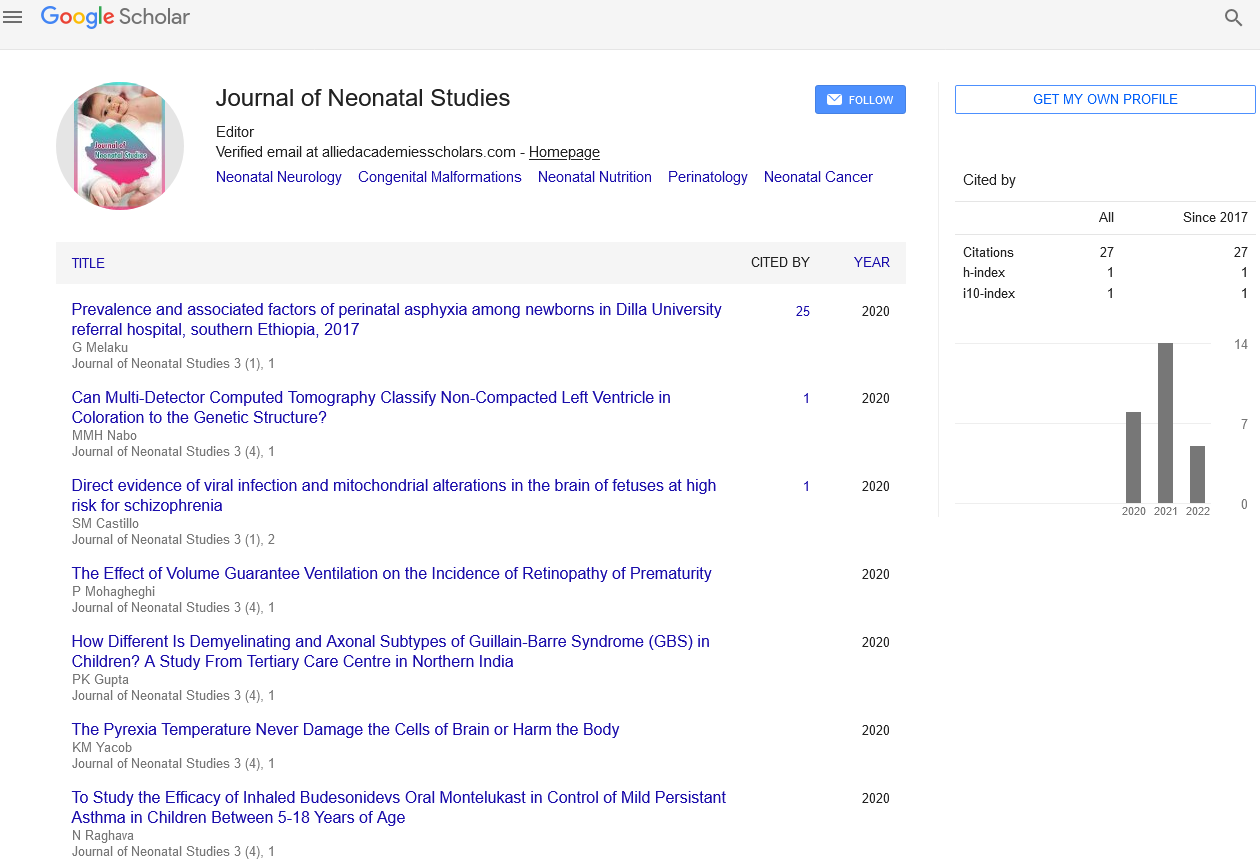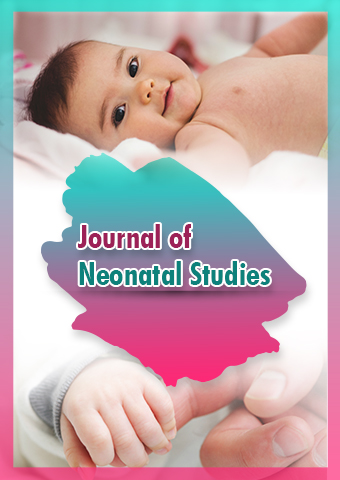Review Article - Journal of Neonatal Studies (2023) Volume 6, Issue 2
Neonatal Cancer: Types of Neonatal Cancer
Gao Wanying*
State Key Laboratory of Bioelectronics, School of Biological Science and Medical Engineering, Southeast University, Nanjing, China
State Key Laboratory of Bioelectronics, School of Biological Science and Medical Engineering, Southeast University, Nanjing, China
E-mail: vassillosfan@edu.it
Received: 01-Apr-2023, Manuscript No. jns-23-96809; Editor assigned: 03-Apr-2023, PreQC No. jns-22- 96809(PQ); Reviewed: 17-Apr-2023, QC No. jns-22-96809; Revised: 21- Apr-2023, Manuscript No. jns-22- 96809(R); Published: 28-Apr-2023; DOI: 10.37532/jns.2023.6(2).47-49
Abstract
Neonatal cancer is a rare type of cancer that occurs in infants up to 28 days old. It is estimated to affect approximately 1 in every 33,000 live births worldwide. The most common types of neonatal cancer are neuroblastoma, leukemia, and brain tumors. Neuroblastoma is the most common type of neonatal cancer and accounts for approximately 50% of cases. It is a cancer that develops from immature nerve cells and can occur in various parts of the body, including the adrenal glands, neck, chest, abdomen, and pelvis. Symptoms of neuroblastoma may include a lump or mass in the abdomen or neck, a swollen belly, and difficulty breathing. Leukemia is another type of neonatal cancer and is characterized by the uncontrolled growth of white blood cells in the bone marrow. The symptoms of leukemia may include fever, fatigue, and frequent infections. Brain tumors are also a rare form of neonatal cancer, but they can be very aggressive and difficult to treat. Symptoms of brain tumors may include headaches, seizures, vomiting, and changes in vision or behavior. The causes of neonatal cancer are not well understood, but some risk factors have been identified. These include genetic mutations, exposure to radiation or certain chemicals, and certain viral infections. Diagnosis of neonatal cancer can be challenging because symptoms may be vague or absent, and diagnostic tests such as biopsies or imaging studies may be difficult to perform on such young infants.
Keywords
Neonatal cancer • Neuroblastoma • Leukemia • Brain tumors • Blood cells • Bone marrow
Introduction
Neonatal cancer, also known as infant cancer, is a rare type of cancer that affects infants within the first 28 days of life. While it is a rare occurrence, it can be devastating for the affected child and their family. Neonatal cancer is different from childhood cancer in several ways, including the types of cancer that can occur, the symptoms, and the treatment options available.
Neonatal cancer can occur in any part of the body, but the most common sites include the kidneys, liver, brain, and blood cells. Some of the common types of neonatal cancer include neuroblastoma, hepatoblastoma, and leukemia. The symptoms of neonatal cancer can vary depending on the type and location of the cancer. Some common symptoms include anemia, difficulty breathing, feeding difficulties, and unexplained weight loss. Due to the rarity of neonatal cancer, it can be difficult to diagnose. However, early detection is crucial for successful treatment. Diagnosis typically involves a series of tests, including blood tests, imaging tests, and biopsies. Treatment options for neonatal cancer depend on the type and stage of the cancer, as well as the infant’s overall health. Treatment options may include surgery, chemotherapy, and radiation therapy. Neonatal cancer can have a significant impact on the infant’s long-term health, including an increased risk of developmental delays and other health issues. Therefore, ongoing medical monitoring is essential to manage any potential long-term effects of the cancer and its treatment [1].
Despite the significant challenges posed by neonatal cancer, ongoing research is leading to promising advances in the diagnosis and treatment of the disease. Early detection, improved treatment options, and ongoing medical monitoring can help improve outcomes for infants with neonatal cancer. With continued research and medical advancements, there is hope for improved outcomes and a brighter future for infants diagnosed with this rare form of cancer.
Treatment options for neonatal cancer may include surgery, chemotherapy, radiation therapy, or a combination of these modalities. However, treatments decisions must take into account the potential risks and benefits of each option, as well as the infant’s overall health and prognosis. Neonatal cancer, also known as infant cancer, is a rare type of cancer that occurs in newborns and infants up to 28 days of age. Although neonatal cancer is rare, it can be a devastating diagnosis for parents and families, as it can be difficult to treat and has a higher mortality rate compared to other types of childhood cancers. In this article, we will discuss the types of neonatal cancer, risk factors, symptoms, diagnosis, treatment, and prognosis [2, 3].
Discussion
Types of Neonatal Cancer
There are various types of neonatal cancer, but the most common types are neuroblastoma, leukemia, and brain tumors.
Neuroblastoma: This is the most common type of neonatal cancer and accounts for about 50% of cases. It affects the nervous system and is usually found in the adrenal glands, which are located above the kidneys. Symptoms include a lump or swelling in the abdomen, loss of appetite, and weight loss.
Leukemia: Leukemia is a cancer of the blood cells and accounts for about 30% of neonatal cancer cases. Symptoms may include anemia, frequent infections, fever, and bruising.
Brain tumors: Brain tumors are rare in neonates, accounting for about 10% of cases. Symptoms may include seizures, headaches, and vomiting.
Risk factors: The cause of neonatal cancer is unknown, but some risk factors may increase the likelihood of a new-born developing cancer. These risk factors include:
Family history: If there is a history of cancer in the family, the risk of neonatal cancer may increase.
Genetic mutations: Certain genetic mutations can increase the risk of cancer, such as mutations in the TP53 gene.
Exposure to toxins: Exposure to certain toxins, such as chemicals or radiation, can increase the risk of neonatal cancer [4, 5].
Symptoms of Neonatal Cancer
The symptoms of neonatal cancer can vary depending on the type of cancer, but some common symptoms include:
• A lump or swelling in the abdomen
• Loss of appetite
• Weight loss
• Anemia
• Frequent infections
• Fever
• Bruising
• Seizures
• Headaches
• Vomiting
Diagnosis
The diagnosis of neonatal cancer can be challenging, as the symptoms can be vague and similar to other conditions. A doctor may perform various tests to diagnose neonatal cancer, including:
Blood tests: Blood tests can detect abnormalities in the blood cells, which may indicate the presence of cancer.
Imaging tests: Imaging tests, such as ultrasounds, MRIs, and CT scans, can detect the presence of tumors in the body.
Biopsy: A biopsy involves removing a small sample of tissue from the tumor and examining it under a microscope to determine if it is cancerous [6].
Treatment of Neonatal Cancer
The treatment of neonatal cancer depends on the type and stage of cancer, as well as the overall health of the new-born. Treatment options may include:
Surgery: Surgery involves removing the tumor from the body. In some cases, surgery may not be possible, depending on the size and location of the tumor.
Chemotherapy: Chemotherapy involves using drugs to kill cancer cells. Chemotherapy may be given before or after surgery, or as the primary treatment for cancer.
Radiation therapy: Radiation therapy involves using high-energy radiation to kill cancer cells. Radiation therapy may be used in combination with chemotherapy or as a standalone treatment.
Stem cell transplant: A stem cell transplant involves replacing the body’s bone marrow with healthy stem cells to help the body produce healthy blood cells.
Prognosis: The prognosis for neonatal cancer can vary depending on the type and stage of cancer.
Overall, neonatal cancer is a rare but serious condition that requires prompt diagnosis and appropriate treatment. The prognosis for neonatal cancer can vary widely depending on the type and stage of cancer, as well as other factors such as the infant’s age, overall health, and response to treatment. Ongoing research into the causes, diagnosis, and treatment of neonatal cancer is needed to improve outcomes for affected infants and their families [7, 8].
Conclusion
Neonatal cancer is a rare but devastating disease that affects infants under the age of one. Although rare, neonatal cancers can be aggressive and difficult to treat, leading to poor outcomes for affected infants and their families. Neonatal cancers are often diagnosed late due to the lack of early screening methods, leading to delays in treatment and poorer outcomes. Recent advancements in medical technology and treatment options have improved the prognosis for neonatal cancer patients, with many infants now able to survive and lead healthy lives. The use of multidisciplinary approaches, such as surgery, chemotherapy, radiation therapy, and stem cell transplantation, has significantly improved survival rates and reduced the side effects of treatment. Despite these advancements, much remains unknown about the causes and risk factors for neonatal cancers, highlighting the need for further research in this area. Additionally, there is a need for more specialized care and support for families affected by neonatal cancer, including access to palliative care services and psychological support. Neonatal cancer remains a significant medical challenge, but advancements in treatment options and multidisciplinary approaches have improved the outcomes for affected infants. Ongoing research into the causes and risk factors for neonatal cancers, as well as specialized care and support for affected families, are crucial to continuing this positive trend and improving the lives of those affected by this devastating disease [9, 10].
Acknowledgement
None
Conflict of Interest
None
References
- Schellenberg ES, Dryden DM, Vandermeer B et al. Lifestyle interventions for patients with and at risk for type 2 diabetes: a systematic review and meta-analysis. Ann Intern Med. 159, 543-551 (2013).
- Schwingshackl L, Hoffmann G, Lampousi AM et al. Food groups and risk of type 2 diabetes mellitus: a systematic review and meta-analysis of prospective studies. Eur J Epidemiol. 32, 363-375 (2017).
- Reynolds A, Mann J, Cummings J et al. Carbohydrate quality and human health: a series of systematic reviews and meta-analyses. Lancet. 393, 434-445 (2019).
- Beccuti G, Monagheddu C, Evangelista A et al. Timing of food intake: Sounding the alarm about metabolic impairments? A systematic review. Pharmacol Res. 125, 132–141 (2017).
- Anderson JW, Ward K. High-carbohydrate, high-fiber diets for insulin-treated men with diabetes mellitus. Am J Clin Nutr. 32, 2312-2321 (1979).
- Booth FW, Chakravarthy MV. Physical activity and dietary intervention for chronic diseases: a quick fix after all. J Appl Physiol. 100, 1439-1440 (2006).
- Roberts CK, Won D, Pruthi S et al. Effect of a short-term diet and exercise intervention on oxidative stress, inflammation, MMP-9, and monocyte chemotactic activity in men with metabolic syndrome factors. J Appl Physiol. 100: 1657-65 (2006).
- Skov J, Eriksson D, Kuja-Halkola R et al. Co-aggregation and heritability of organ-specific autoimmunity: a population-based twin study. Eur J Endocrinol 182, 473-480 (2020).
- Hyttinen V, Kaprio J, Kinnunen L et al. (2003) Genetic liability of type 1 diabetes and the onset age among 22,650 young Finnish twin pairs: a nationwide follow-up study. Diabetes. 52,1052-1055.
- Tinajero MG, Malik VS. An Update on the Epidemiology of Type 2 Diabetes: A Global Perspective. Endocrinol Metab Clin.50, 337-355 (2021).
Indexed at, Google Scholar, Crossref
Indexed at, Google Scholar, Crossref
Indexed at, Google Scholar, Crossref
Indexed at, Google Scholar, Crossref
Indexed at, Google Scholar, Crossref
Indexed at, Google Scholar, Crossref
Indexed at, Google Scholar, Crossref
Indexed at, Google Scholar, Crossref
Indexed at, Google Scholar, Crossref

